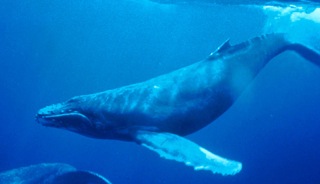Extreme Breath Holding: Marine Mammal Diving
by Emily Nelson, RJD Intern
Sperm whales have been recorded diving to depths well over 2,000 meters. Elephant seals have recorded dives lasting over 2 hours. Humans, on average, can hold their breath underwater for less than 30 seconds. How is it that marine mammals spend such long periods of time underwater, diving to incredible depths? After all, they breathe oxygen just as terrestrial mammals do. The answer lies in the many adaptations these animals have acquired over time that completely change how oxygen is stored, delivered, and used in the body.
Contrary to what you may think, the lungs are not a primary site of oxygen storage in marine mammals. The purpose of the lung is to exchange gases between blood and the air. This function is largely restricted while diving; with increasing pressure, resulting from increasing depth, the lungs and trachea decrease in size and eventually collapse. However, this collapse helps to prevent nitrogen narcosis. Commonly known s the bends, this is a problem and concern for SCUBA divers. At depth nitrogen moves into the bloodstream rapidly and can cause gas bubbles to form in the body, blocking the flow of oxygen. In marine mammals, as lung size decreases air is forced into the upper airway spaces. These areas do not exchange gases with the blood and thus nitrogen is prevented from entering the blood stream altogether, allowing them to avoid the bends.
Despite decreased lung capacity, increased total body oxygen is a necessary component in the ability of marine mammals to hold their breath. /’|/Oxygen consumed during a dive is stored in three areas: muscles, blood, and lungs. Marine mammals have large stores of oxygen in their muscles and blood, acting almost like an on board scuba tank. Myoglobin (oxygen binding protein in muscle) is present at levels three to seven times higher than in terrestrial mammals. This internal store of oxygen is used for much of the animal’s aerobic metabolic needs. In addition, the amount of blood in a marine mammal is proportional to the depth at which it dives. Increased blood volume and hemoglobin (oxygen binding protein in blood) lead to higher oxygen stores. The concentration of red blood cells is also increased. Red blood cells carry oxygen, and as an animal starts a dive it sends red blood cells through the blood stream until it returns to the surface. The extent to which an animal shows these adaptations varies between species, but the amount of oxygen available and its utilization has a big impact on how long an animal can hold its breath for all marine mammals.
In addition to marine mammals’ increased ability to store oxygen, they can also decrease their oxygen consumption during a dive using bradycardia and selective ischemia. Bradycardia is a rapid decrease in heart rate upon starting a dive. An orca whale has the ability to go from a heart rate of 60 beats per minute to 30 beats per minute in a matter of 15 seconds. Heart rate during a dive is nearly the same as heart rate experienced during a respiratory pause. This decreased heart rate is then maintained for the duration of an animal’s dive. Because the heart is beating slower it is performing less work and oxygen consumption is reduced. The extent to which bradycardia occurs is proportional to the length of the dive, the longer a dive the slower the heart rate. As a dive nears completion an animals’ heart rate increases drastically in process known as anticipatory tachycardia.
Selective ischemia is the redistribution of blood to the most vital organs, the brain and heart. This deprives the kidneys and liver of blood and they may shut down during the dive. By limiting blood circulation oxygen is conserved and metabolic rate is decreased. Blood flow to muscles is minimal, but they still need to function in order to swim. Muscles can rely on internal myoglobin stores as well as anaerobic (without oxygen) metabolism. Muscles can withstand anaerobic metabolism due to their high tolerance for lactate. Upon surfacing blood flow returns to normal and these areas are flushed with blood, coming back to normal function almost immediately.
These are among the major adaptations marine mammals have gathered over time, allowing them to dive longer and to greater depths than any terrestrial mammal. They have the ability to readily adapt from surface conditions to conditions at extreme depths. However, there is still a lot to be learned about how these animals can survive under such unique circumstances.
REFERENCES
Hoelzel, A. Rus. Marine Mammal Biology: An Evolutionary Approach. Oxford: Blackwell Science, 2002. Print.
Kooyman, Gerald L. “Marine Mammal Diving.” Encyclopedia of Marine Mammals. 2nd ed. Oxford: Academic, n.d. 327-32. Print.
Richardson, Jill. “Anatomy and Physiology II.” MSC 350. University of Miami, Coral Gables. Mar. 2013. Lecture.






They are indeed amazing creatures, able to withstand physical challenges like that. How they are created to adapt to the demands of the deep is really astounding. Wish humans are built like that, because as a diver, that would be a great ability to have.